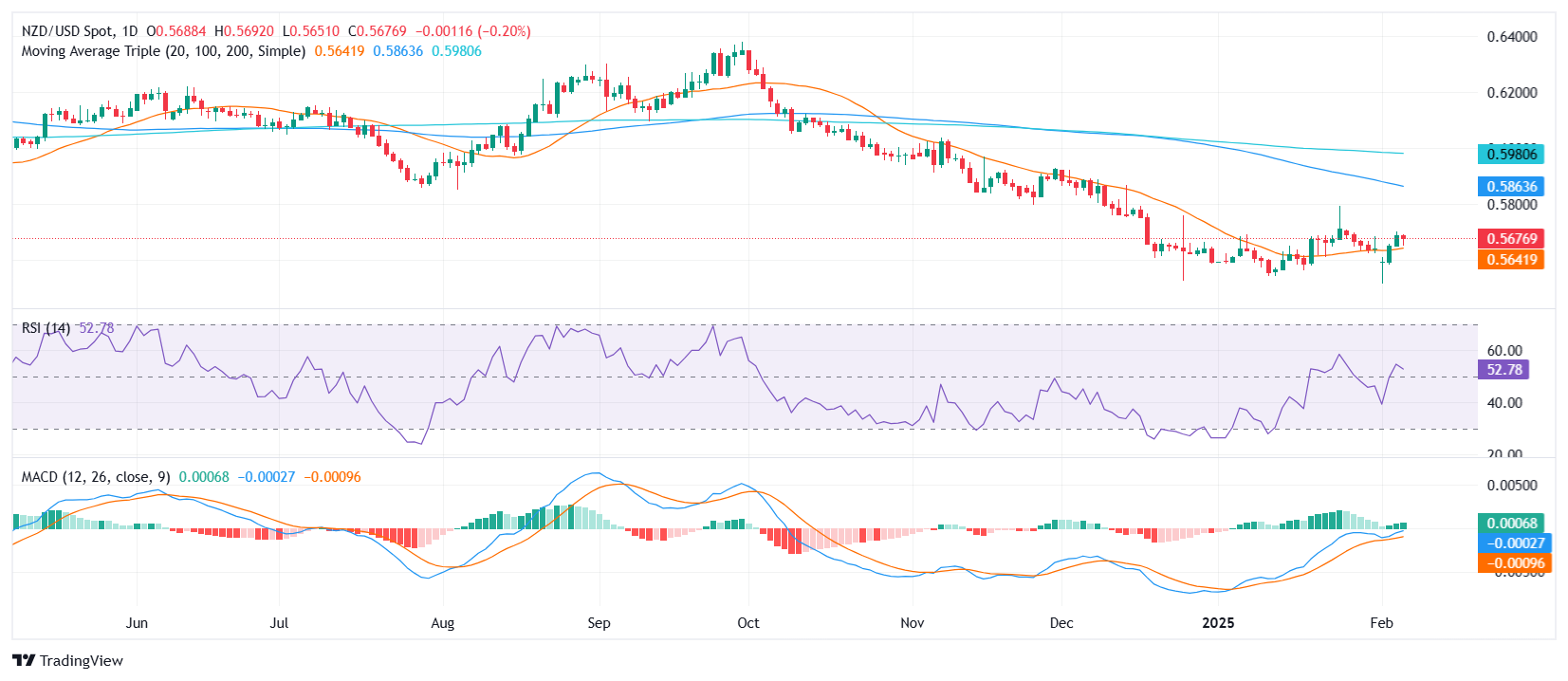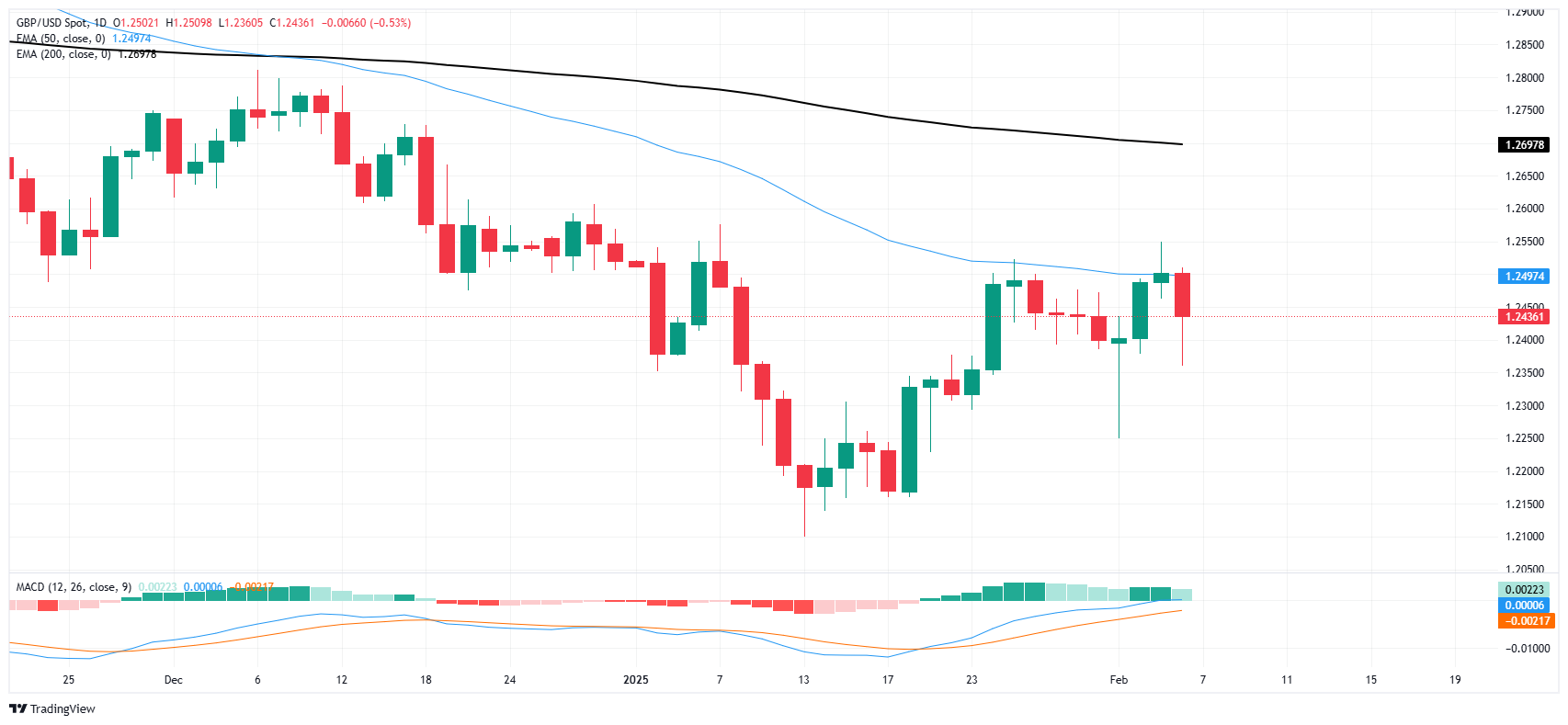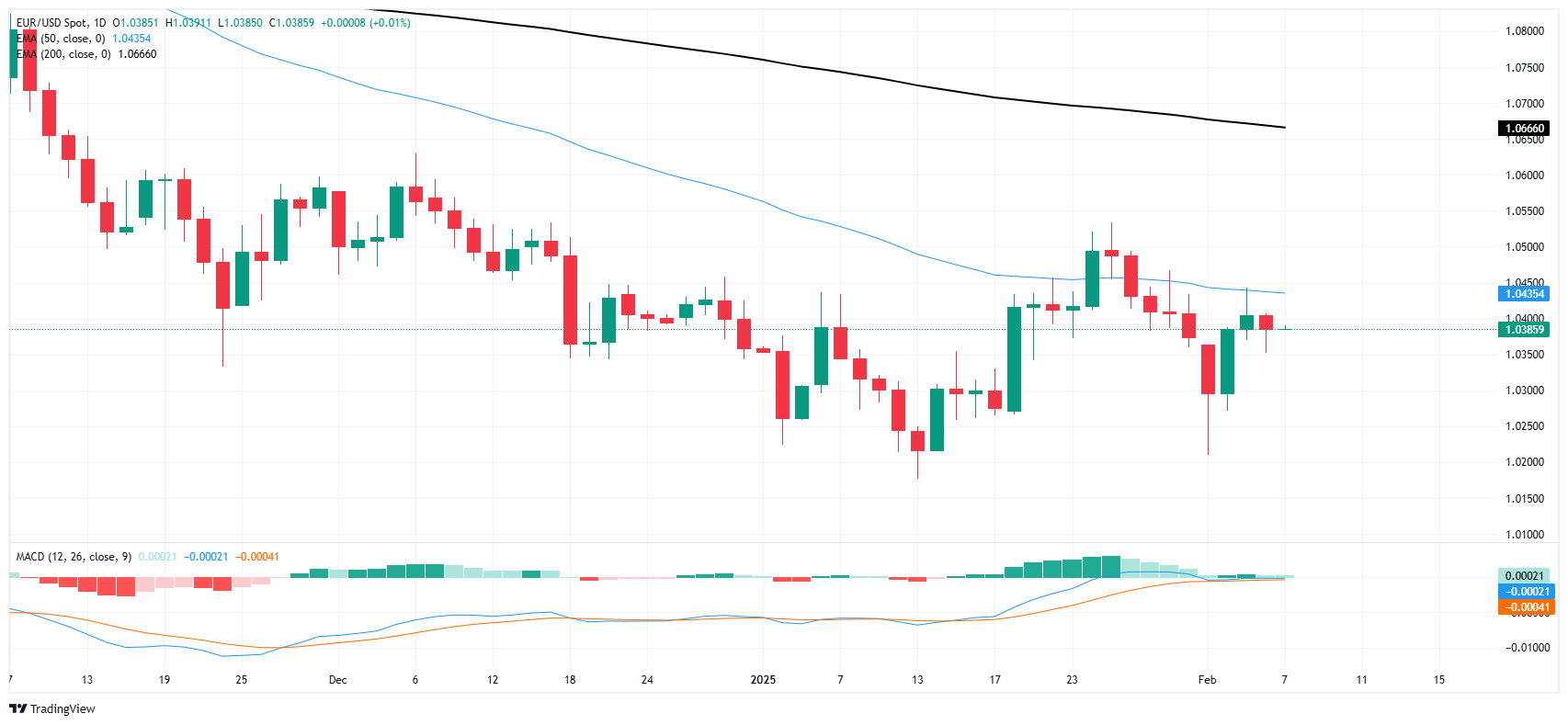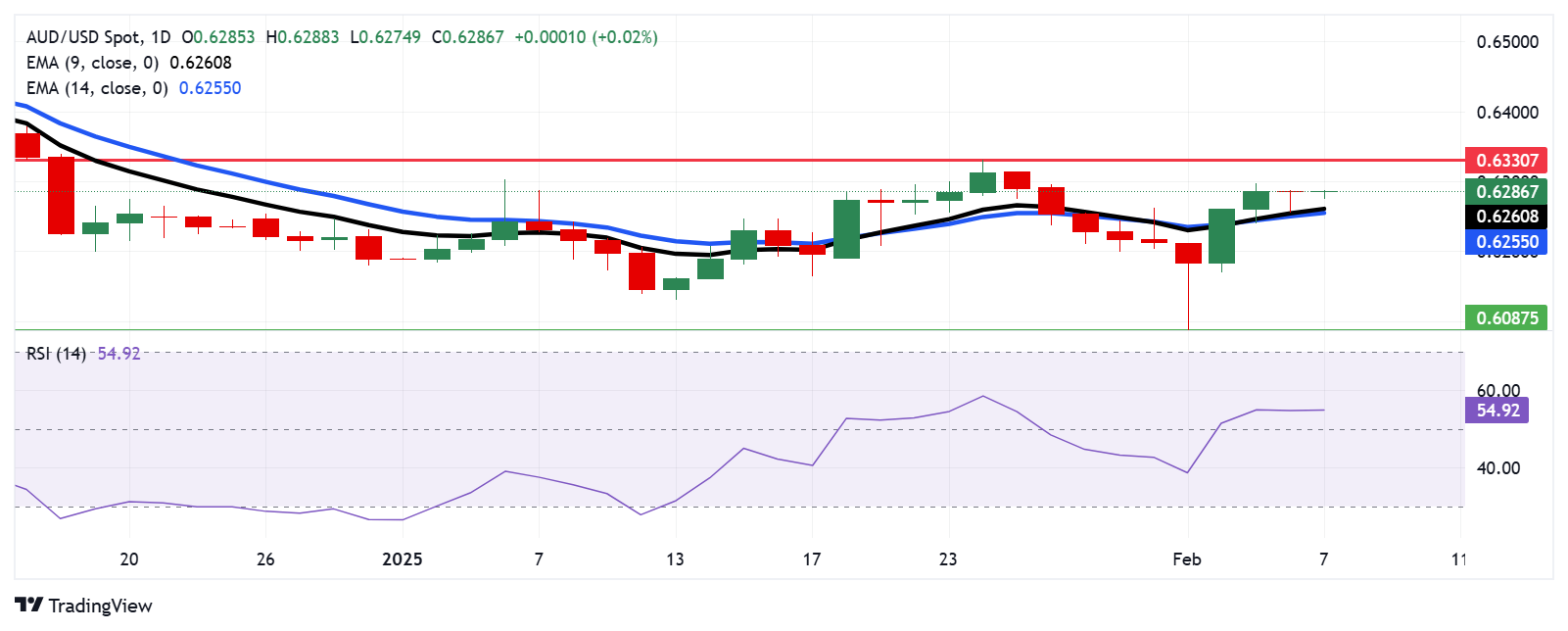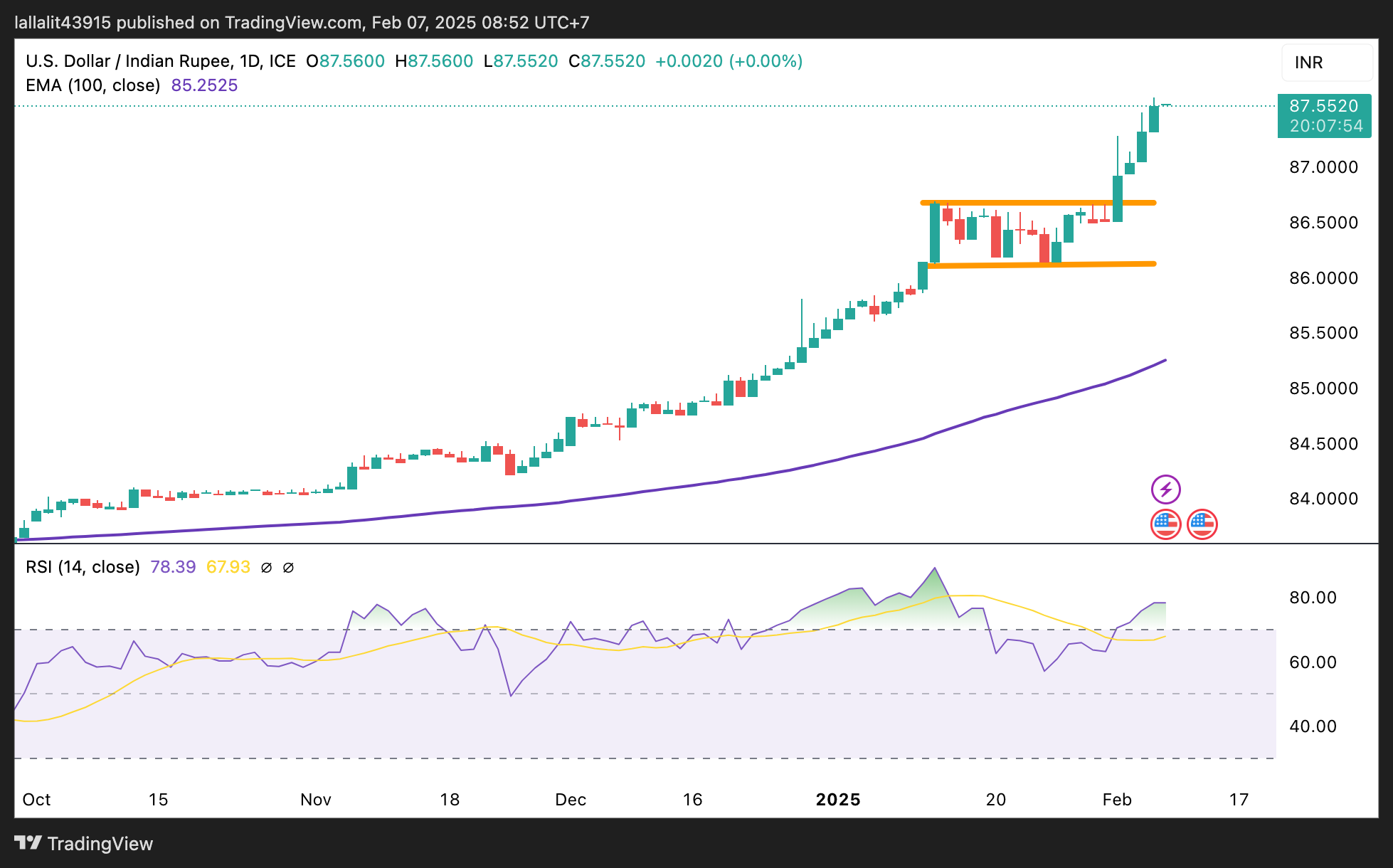Australian Dollar softens as RBA cut bets and trade tensions weigh, US NFP looms 6 February 2025, 22:47 •Aussie dips near 0.6280 amid trade gloom. •RBA likely to cut rates to 4.1%, capping Aussie gains. •Markets await US labor data for fresh momentum. •Soft Trade Balance data from Australia also affected the Aussie. The Australian Dollar (AUD) softens to around 0.6280 in Thursday’s American session, tallying nearly 0.30% losses. Expectations of a Reserve Bank of Australia (RBA) rate cut and revived United States (US)-China tariff anxieties hamper the pair’s upside. Meanwhile, attention shifts to the United States labor market report on Friday, with the Aussie bracing for further volatility. Daily digest market movers: Aussie edges lower as US Dollar recovers •On the local front, Australia’s trade surplus shrank to 5,085M in December from 6,792M, below expectations of 7,000M, as exports rose just 1.1% while imports surged 5.9%. •Markets now price a 95% chance of an RBA rate cut from 4.35% to 4.10%, undermining the Aussie’s resilience. •US President Donald Trump floats the idea of higher tariffs on the Eurozone and China, pressuring the China-linked Australian Dollar. •The US Dollar finds support from hawkish Federal Reserve expectations, although weaker labor data could curb USD demand. •Investors are now focusing on Friday’s Nonfarm Payrolls report, projected to show 170,000 new jobs in January, down from December’s 256,000. •Jobless Claims raised concerns as Initial claims rose to 219,000, surpassing expectations of 213,000 and up from last week’s 208,000, signaling potential labor market softening. •Continuing jobless claims increase to 1.886 million, above the forecast of 1.87 million. AUD/USD technical outlook: Mild retracement stalls near 20-day SMA The pair declined to 0.6280 on Thursday, after surging past the 20-day Simple Moving Average at approximately 0.6230. The Relative Strength Index (RSI) stands at 55, still in positive territory but declining. Meanwhile, the Moving Average Convergence Divergence (MACD) histogram shows decreasing green bars, hinting at waning bullish momentum. Although the Aussie’s near-term support may hold above 0.6200, dovish RBA expectations and renewed tariff worries could keep any further advances below the 0.6300 resistance in check. A hold of the 20-day SMA would reject any bearish threats, at least for the short term. Australian Dollar FAQs What key factors drive the Australian Dollar? One of the most significant factors for the Australian Dollar (AUD) is the level of interest rates set by the Reserve Bank of Australia (RBA). Because Australia is a resource-rich country another key driver is the price of its biggest export, Iron Ore. The health of the Chinese economy, its largest trading partner, is a factor, as well as inflation in Australia, its growth rate and Trade Balance. Market sentiment – whether investors are taking on more risky assets (risk-on) or seeking safe-havens (risk-off) – is also a factor, with risk-on positive for AUD. How do the decisions of the Reserve Bank of Australia impact the Australian Dollar? The Reserve Bank of Australia (RBA) influences the Australian Dollar (AUD) by setting the level of interest rates that Australian banks can lend to each other. This influences the level of interest rates in the economy as a whole. The main goal of the RBA is to maintain a stable inflation rate of 2-3% by adjusting interest rates up or down. Relatively high interest rates compared to other major central banks support the AUD, and the opposite for relatively low. The RBA can also use quantitative easing and tightening to influence credit conditions, with the former AUD-negative and the latter AUD-positive. How does the health of the Chinese Economy impact the Australian Dollar? China is Australia’s largest trading partner so the health of the Chinese economy is a major influence on the value of the Australian Dollar (AUD). When the Chinese economy is doing well it purchases more raw materials, goods and services from Australia, lifting demand for the AUD, and pushing up its value. The opposite is the case when the Chinese economy is not growing as fast as expected. Positive or negative surprises in Chinese growth data, therefore, often have a direct impact on the Australian Dollar and its pairs. How does the price of Iron Ore impact the Australian Dollar? Iron Ore is Australia’s largest export, accounting for $118 billion a year according to data from 2021, with China as its primary destination. The price of Iron Ore, therefore, can be a driver of the Australian Dollar. Generally, if the price of Iron Ore rises, AUD also goes up, as aggregate demand for the currency increases. The opposite is the case if the price of Iron Ore falls. Higher Iron Ore prices also tend to result in a greater likelihood of a positive Trade Balance for Australia, which is also positive of the AUD. How does the Trade Balance impact the Australian Dollar? The Trade Balance, which is the difference between what a country earns from its exports versus what it pays for its imports, is another factor that can influence the value of the Australian Dollar. If Australia produces highly sought after exports, then its currency will gain in value purely from the surplus demand created from foreign buyers seeking to purchase its exports versus what it spends to purchase imports. Therefore, a positive net Trade Balance strengthens the AUD, with the opposite effect if the Trade Balance is negative.
Here is what you need to know on Friday, February 7:
The US Dollar Index (DXY) managed to reclaim some ground lost helped by a mild bounce in US yields and a hiccup in the risk-linked universe. The January Nonfarm Payrolls will be the salient event at the end of the week, seconded by the preliminary Michigan Consumer Sentiment, and Wholesale Inventories.
EUR/USD saw its upside momentum somewhat curtailed, retreating to the mid-1.0300s on the back of the better tone in the US Dollar. Germany’s Balance of Trade results will be released along with the speech by the ECB’s De Guindos.
GBP/USD tumbled to three-day lows and revisited the 1.2360 region on the back of the BoE’s rate cut and USD buying. The BBA’s Mortgage Rate, the Halifax House Price Index and the speech by the BoE’s Pill are all due across the Channel.
USD/JPY kept its decline well in place, retesting two-month lows in the 151.80 region on the back of intense buying interest around the Japanese yen. Household Spending figures, and the advanced Coincident Index and Leading Economic Index will be published.
AUD/USD’s weekly recovery came short of the 0.6300 hurdle, sparking a corrective decline on Thursday on the back of the widespread gains in the US Dollar.
Further weakness saw prices of the American WTI approach the key contention zone around $70.00 per barrel, or fresh five-week lows.
Gold prices halted their five-day bullish move on Thursday, coming under fresh selling pressure a day after hitting an all-time peak past the $2,880 mark per ounce troy. Silver prices followed suit, dropping markedly to the sub-$32.00 mark per ounce.
